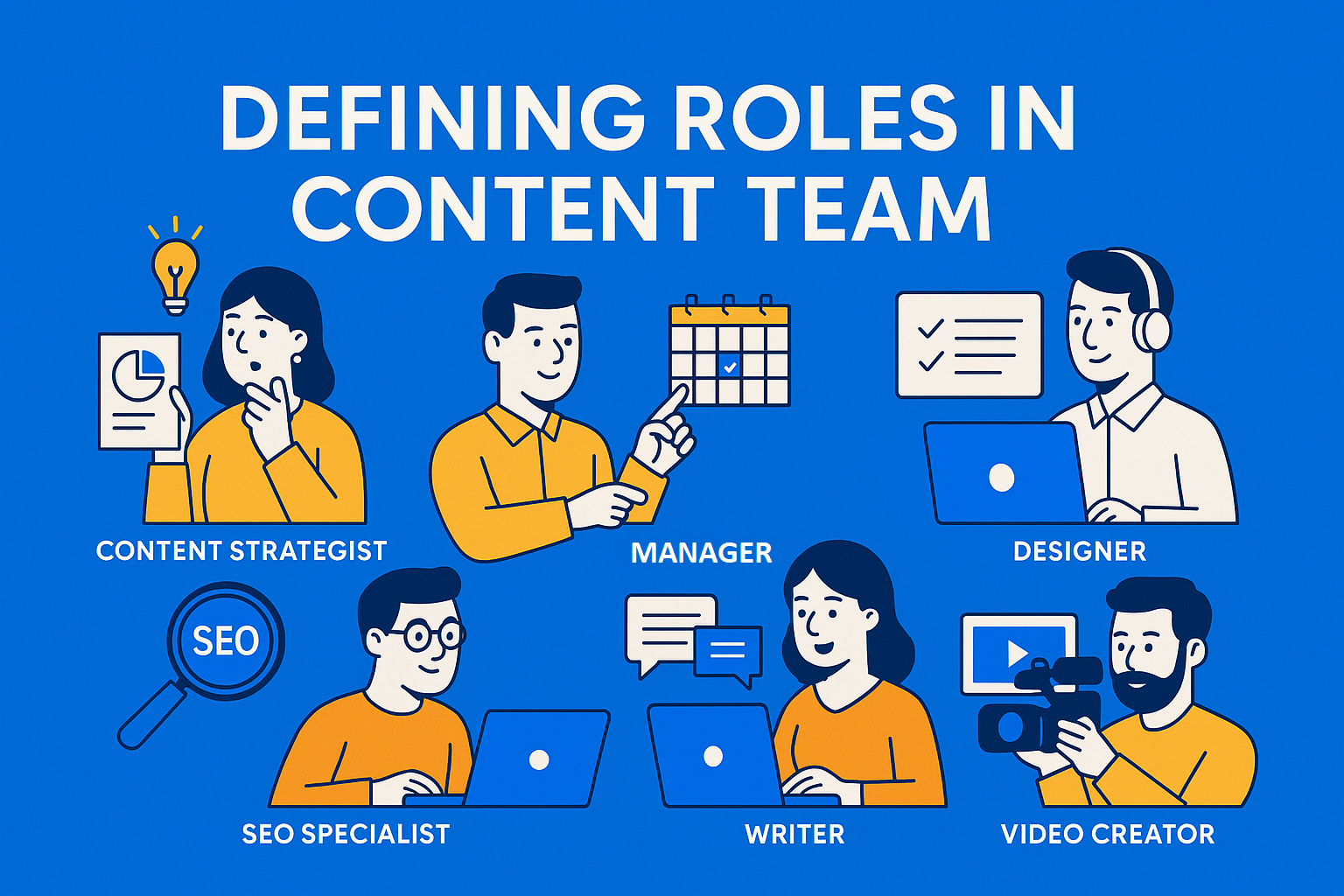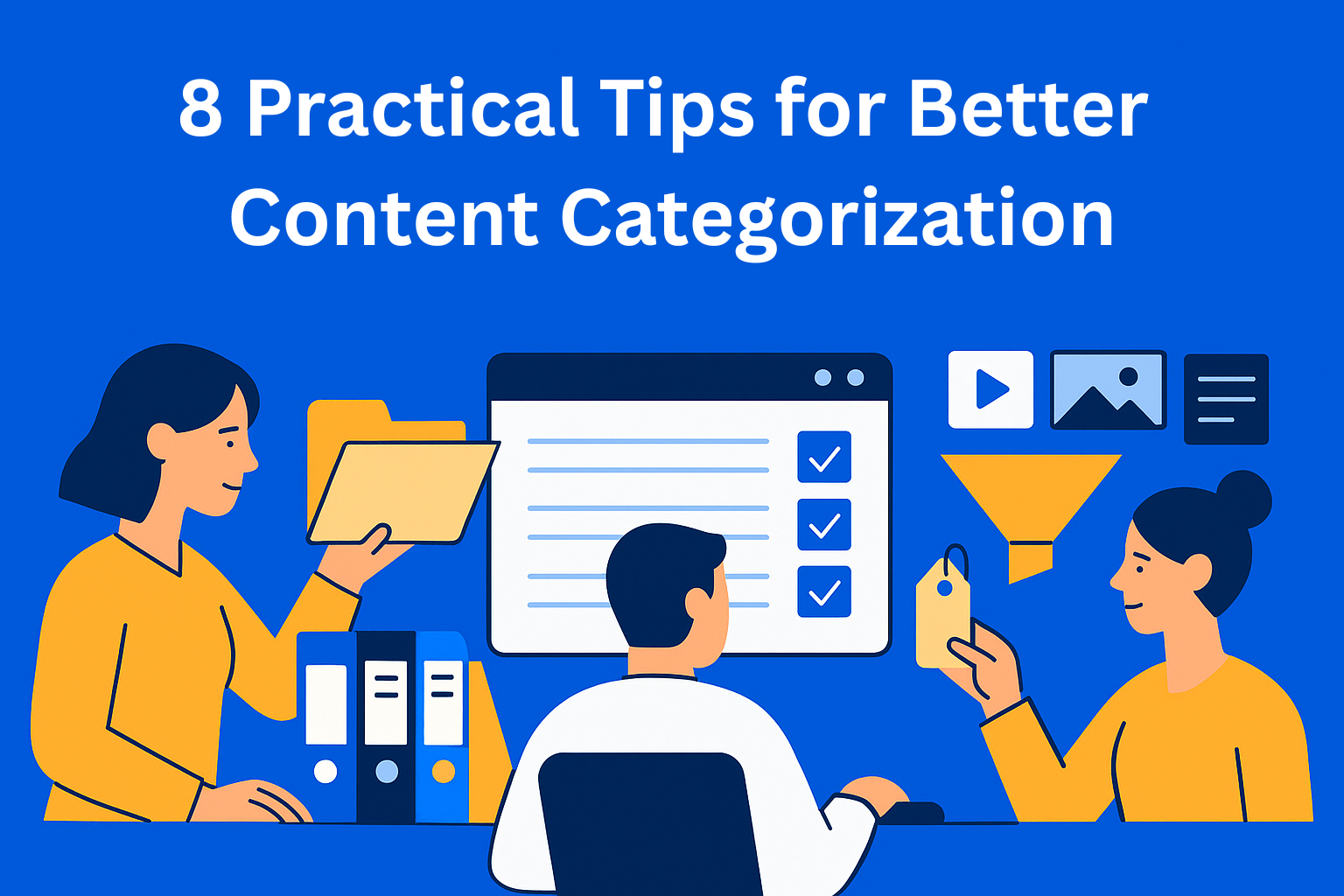Roles in Content Team: Who Does What?
Clearly defined roles in a content team are key to an effective strategy. Discover who does what, how tasks are organized, and why tools like EasyContent are essential for better collaboration, higher productivity, and better content quality.

In every content team, it's important that everyone knows exactly what their task is. When roles aren't clearly defined, confusion happens: tasks overlap, deadlines are missed, and content quality drops. On the other hand, when responsibilities are clearly divided and everyone knows who is responsible for what, the whole process - from planning topics to publishing - works much better.
In this text, we’ll go through some of the roles that content teams should have, and what their responsibilities are in the process from idea to execution.
Key Takeaways
- Clear roles prevent chaos - Well-defined responsibilities improve collaboration and reduce task overlap.
- The strategist defines direction - They align content topics with business goals and audience needs.
- The manager coordinates execution - From scheduling to team alignment, they keep things on track.
- SEO specialists make content visible - Their role is to boost discoverability with keywords and technical guidance.
- Writers shape the message - Whether it’s informative or persuasive, they bring content to life with clarity and creativity.
- Editors ensure quality and consistency - They polish language, maintain tone, and validate SEO elements.
- Designers & video creators enhance engagement - They turn text into impactful visual formats tailored for each channel.
- Promotion roles amplify reach - Social, email, and paid media experts make sure content finds its audience.
- EasyContent streamlines collaboration - It helps teams assign roles, manage workflows, and stay aligned.
- Structure = efficiency - When everyone knows their role, the team works faster, smarter, and more effectively.
Content Strategist: The Brain of the Operation
The content strategist is the person who plans the entire content strategy and ensures that every piece of content has a clear purpose. They define what we want to achieve with content, choose topics that will be interesting to the target audience, and guide the team so that everything created aligns with the company's business goals.
To do this job successfully, the strategist must understand the market, audience behavior, and how people access information. Through research and analysis of existing content, they lay the foundation for the strategy.
In addition, they often work closely with SEO experts to ensure that the chosen topics are not only useful, but also easy to find through search, a key factor for SEO success.
Content Manager: The Process Coordinator
The content manager is the person who makes sure everything goes according to plan. While the strategist creates the plan and goals, the manager monitors whether those goals are being carried out. They organize the publishing schedule (editorial calendar), help team members understand their next task, and ensure all deadlines are met.
That’s why tools like EasyContent are helpful. This tool makes it easier to assign tasks, view the status of each piece of content, and automatically notify the team when something is ready for the next step. That immediately means fewer mistakes, better coordination, and more focus on content quality.
SEO Specialist: The One Who Makes Content Findable
The SEO specialist has a clear goal – to make the content your team creates as visible as possible on Google and other search engines. To achieve this, they research which keywords people use, analyze what the competition is doing, and optimize content to rank better.
They also work with writers to ensure keywords are smartly placed - in titles, subtitles, meta descriptions, and image alt tags. All this increases the chances of content being found. In addition, they give recommendations for technical improvements on the site and use tools like Ahrefs, SEMrush, and Google Search Console to track results and find new optimization opportunities.
Writer (Content Writer/Copywriter): The Creative Pillar
The writer is the one who “puts the idea on paper.” Depending on the goal, they can be a content writer - writing educational and informative texts like blogs and guides, or a copywriter - writing sales and promotional texts, such as ads and email campaigns.
A good writer doesn’t just write correctly, they write in an engaging way. They understand the brand’s voice and style, know how to grab attention and hold the reader’s interest, and guide them through the text to the desired action. Besides creativity, it’s important that they can naturally weave keywords into the text without disrupting the flow, which is important for both SEO and user experience.
Editor: Final Quality Control
The editor is the last line of defense before content sees the light of day. Their responsibility is to make sure the text is stylistically consistent, free of grammar mistakes, and reflects the brand’s tone of voice.
Editors often use a style guide as a reference and work with writers to improve the text’s structure, clarity, and flow. They also check SEO elements and suggest edits to make content as optimized as possible for search engines.
Designer and/or Video Creator: Visual Support
Today, as people increasingly consume visual content, content teams can’t function without designers and video creators. Their task is to turn text into visual formats - whether it’s illustrations, infographics, animations, or video clips, which further grab attention and increase audience engagement.
Designers work with writers to ensure visuals clearly support the message of the text. On the other hand, video creators usually collaborate with the content strategist to develop materials that can be adapted to different platforms (YouTube, social media, website). That way, content becomes more versatile and reaches a broader audience.
Distribution and Promotion: Who Spreads the Word?
The best content is useless if it doesn’t reach the audience. That’s where roles like social media manager, email marketing specialist, and paid media manager come into play.
They develop strategies to place content on the right channels, at the right time, for the right audience. They also track success metrics and give feedback to the team so that future content can better align with goals.
How Tools Like EasyContent Help with Role Assignment and Collaboration
EasyContent is a tool that helps teams organize their work more easily. It allows you to precisely define who is responsible for what, assign tasks, and see the status of any piece of content at any time. This is especially useful for teams where multiple people work on the same content.
Thanks to features like customizable workflow, real-time collaboration, customizable templates, content calendar, etc.. the whole team can collaborate without wasting time on emails and messages. Everything is clear and visible, which improves communication and speeds up task completion, key for a successful content strategy.
EasyContent gives you the ability to create a separate workflow for each project, add team members to every step of the workflow, and assign them permissions, helping you avoid the risk of any task being left unfinished.
Conclusion: The Power of Clear Structure
If you want your content team to work efficiently and without chaos, clearly defined roles are absolutely necessary. When everyone knows what their task is, it’s easier to plan, easier to communicate, and the team achieves better results together. There’s no task duplication, fewer mistakes, and content quality improves.
If your team still doesn’t have clearly defined roles, now is the right time to create a structure. And if you need a tool to help you organize things simply and clearly, EasyContent is a great choice, especially when several people are involved in one content process. If you'd like to try out how EasyContent works with your team, we're offering a two-week free trial, and if needed, we can extend the trial period.
Now that you have a clear picture of who should do what, are you ready to take your content team to the next level?






